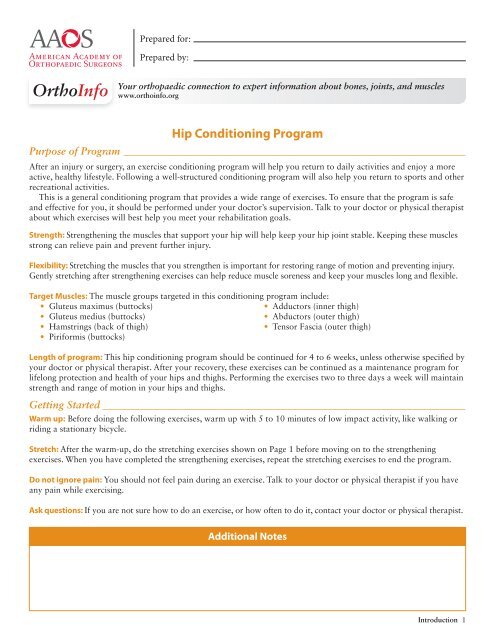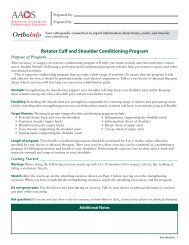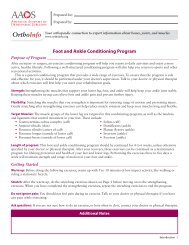Hip Conditioning Program - AAOS - American Academy of ...
Hip Conditioning Program - AAOS - American Academy of ...
Hip Conditioning Program - AAOS - American Academy of ...
You also want an ePaper? Increase the reach of your titles
YUMPU automatically turns print PDFs into web optimized ePapers that Google loves.
OrthoInfo<br />
Prepared for:<br />
Prepared by:<br />
Your orthopaedic connection to expert information about bones, joints, and muscles<br />
www.orthoinfo.org<br />
<strong>Hip</strong> <strong>Conditioning</strong> <strong>Program</strong><br />
Purpose <strong>of</strong> <strong>Program</strong> _________________________________________________________________<br />
After an injury or surgery, an exercise conditioning program will help you return to daily activities and enjoy a more<br />
active, healthy lifestyle. Following a well-structured conditioning program will also help you return to sports and other<br />
recreational activities.<br />
This is a general conditioning program that provides a wide range <strong>of</strong> exercises. To ensure that the program is safe<br />
and effective for you, it should be performed under your doctor’s supervision. Talk to your doctor or physical therapist<br />
about which exercises will best help you meet your rehabilitation goals.<br />
Strength: Strengthening the muscles that support your hip will help keep your hip joint stable. Keeping these muscles<br />
strong can relieve pain and prevent further injury.<br />
Flexibility: Stretching the muscles that you strengthen is important for restoring range <strong>of</strong> motion and preventing injury.<br />
Gently stretching after strengthening exercises can help reduce muscle soreness and keep your muscles long and exible.<br />
Target Muscles: The muscle groups targeted in this conditioning program include:<br />
• Gluteus maximus (buttocks)<br />
• Gluteus medius (buttocks)<br />
• Hamstrings (back <strong>of</strong> thigh)<br />
• Piriformis (buttocks)<br />
• Adductors (inner thigh)<br />
• Abductors (outer thigh)<br />
• Tensor Fascia (outer thigh)<br />
Length <strong>of</strong> program: This hip conditioning program should be continued for 4 to 6 weeks, unless otherwise speci ed by<br />
your doctor or physical therapist. After your recovery, these exercises can be continued as a maintenance program for<br />
lifelong protection and health <strong>of</strong> your hips and thighs. Performing the exercises two to three days a week will maintain<br />
strength and range <strong>of</strong> motion in your hips and thighs.<br />
Getting Started _____________________________________________________________________<br />
Warm up: Before doing the following exercises, warm up with 5 to 10 minutes <strong>of</strong> low impact activity, like walking or<br />
riding a stationary bicycle.<br />
Stretch: After the warm-up, do the stretching exercises shown on Page 1 before moving on to the strengthening<br />
exercises. When you have completed the strengthening exercises, repeat the stretching exercises to end the program.<br />
Do not ignore pain: You should not feel pain during an exercise. Talk to your doctor or physical therapist if you have<br />
any pain while exercising.<br />
Ask questions: If you are not sure how to do an exercise, or how <strong>of</strong>ten to do it, contact your doctor or physical therapist.<br />
Additional Notes<br />
Introduction 1
OrthoInfo<br />
Your orthopaedic connection to expert information about bones, joints, and muscles<br />
www.orthoinfo.org<br />
1. Standing Iliotibial Band Stretch ____________________________________________________<br />
Repetitions<br />
2 sets <strong>of</strong> 4<br />
Days per week<br />
Daily<br />
Main muscles worked: Tensor fascia<br />
You should feel this stretch at the outside <strong>of</strong> your hip<br />
Equipment needed: None<br />
<strong>Hip</strong> <strong>Conditioning</strong> <strong>Program</strong><br />
STRETCHING EXERCISES<br />
Step-by-step directions<br />
• Stand next to a wall for support<br />
• Cross the leg that is closest to the wall behind your other leg.<br />
• Lean your hip toward the wall until you feel a stretch at the outside <strong>of</strong><br />
your hip. Hold the stretch for 30 seconds.<br />
• Repeat on the opposite side, then repeat the entire sequence 4 times.<br />
Tip Do not lean forward or twist at the waist.<br />
2. Seated Rotation Stretch ___________________________________________________________<br />
Repetitions<br />
2 sets <strong>of</strong> 4<br />
Days per week<br />
Daily<br />
Main muscles worked: Piriformis<br />
You should feel this stretch in your buttocks, as well as at your sides<br />
Equipment needed: None<br />
Step-by-step directions<br />
• Sit on the oor with both legs straight in front <strong>of</strong> you.<br />
Cross one leg over the other.<br />
• Slowly twist toward your bent leg, putting your hand<br />
behind you for support.<br />
• Place your opposite arm on your bent thigh and use it to<br />
help you twist further.<br />
• Look over your shoulder and hold the stretch for 30 seconds. Slowly come back to center.<br />
• Reverse leg positions and repeat the stretch on the other side. Repeat the entire sequence 4 times.<br />
Tip Keep your sit bones pressed into the oor throughout the stretch.<br />
© <strong>American</strong> <strong>Academy</strong> <strong>of</strong> Orthopaedic Surgeons Exercises Page 1
OrthoInfo<br />
Your orthopaedic connection to expert information about bones, joints, and muscles<br />
www.orthoinfo.org<br />
3. Knee to Chest ____________________________________________________________________<br />
Repetitions<br />
2 sets <strong>of</strong> 4<br />
Days per week<br />
Daily<br />
Main muscles worked: Gluteus maximus, gluteus medius<br />
You should feel this stretch in your buttocks<br />
Equipment needed: None<br />
Step-by-step directions<br />
• Lie on your back on the oor with your legs extended<br />
straight out.<br />
• Bend one knee and grasp your shinbone with your hands.<br />
• Gently pull your knee toward your chest as far as it will go.<br />
• Hold the stretch for 30 seconds and then relax for 30 seconds.<br />
• Repeat on the other side, then pull both legs in together. Repeat the entire sequence 4 times.<br />
Tip Keep your lower back pressed into the oor.<br />
4. Supine Hamstring Stretch __________________________________________________________<br />
Repetitions<br />
2 sets <strong>of</strong> 4<br />
Days per week<br />
Daily<br />
Main muscles worked: Hamstrings<br />
You should feel this stretch at the back <strong>of</strong> your thigh and behind your knee<br />
Equipment needed: None<br />
<strong>Hip</strong> <strong>Conditioning</strong> <strong>Program</strong><br />
STRETCHING EXERCISES<br />
Step-by-step directions<br />
• Lie on the oor with both knees bent.<br />
• Lift one leg <strong>of</strong>f <strong>of</strong> the oor and bring the knee toward your<br />
chest. Clasp your hands behind your thigh below your knee.<br />
• Straighten your leg and then pull it gently toward your head<br />
until you feel a stretch. (If you have dif culty clasping your<br />
hands behind your leg, loop a towel around your thigh.<br />
Grasp the ends <strong>of</strong> the towel and pull your leg toward you.)<br />
• Hold for 30 to 60 seconds and then relax for 30 seconds.<br />
• Repeat on the other side, then repeat the entire sequence<br />
4 times.<br />
Tip Do not pull at your knee joint.<br />
© <strong>American</strong> <strong>Academy</strong> <strong>of</strong> Orthopaedic Surgeons Exercises Page 2
OrthoInfo<br />
Your orthopaedic connection to expert information about bones, joints, and muscles<br />
www.orthoinfo.org<br />
5. <strong>Hip</strong> Abduction ___________________________________________________________________<br />
Repetitions<br />
8<br />
Days per week<br />
2 to 3<br />
Main muscles worked: Gluteus medius, abductors<br />
You should feel this exercise at your outer thigh and buttocks<br />
Equipment needed: Begin with a weight that allows 8 repetitions and progress to 12 repetitions.<br />
As the exercise becomes easier, add weight in 1-pound increments. Each time you increase the<br />
weight, start again at 8 repetitions, working back up to 12.<br />
Step-by-step directions<br />
• Lie on your side with your injured leg on top and<br />
the bottom leg bent to provide support.<br />
• Straighten your top leg and slowly raise it to 45°.<br />
Keep your knee straight, but not locked.<br />
• Hold this position for 5 seconds.<br />
• Slowly lower your leg and relax it for 2 seconds.<br />
• Repeat, then complete exercise on the other side.<br />
Tip Do not turn your leg in an e ort to raise it higher. The outside <strong>of</strong> your thigh should be lifted toward the ceiling.<br />
6. <strong>Hip</strong> Adduction ___________________________________________________________________<br />
Repetitions<br />
8<br />
Days per week<br />
2 to 3<br />
<strong>Hip</strong> <strong>Conditioning</strong> <strong>Program</strong><br />
STRENGTHENING EXERCISES<br />
Main muscles worked: Adductors<br />
You should feel this exercise at your inner thigh<br />
Equipment needed: Begin with a weight that allows 8 repetitions and progress to 12 repetitions.<br />
As the exercise becomes easier, add weight in 1-pound increments. Each time you increase the<br />
weight, start again at 8 repetitions, working back up to 12.<br />
Step-by-step directions<br />
• Lie on the side <strong>of</strong> your injured leg with both legs straight.<br />
• Bend your top leg and cross it over your injured leg.<br />
• Raise your injured leg 6” to 8” <strong>of</strong>f <strong>of</strong> the oor.<br />
• Hold this position for 5 seconds.<br />
• Slowly lower your leg and rest for 2 seconds.<br />
• Repeat, then complete exercise on the other side.<br />
Tip Place your hand on the oor in front <strong>of</strong> your abdomen to prevent you from leaning backward.<br />
© <strong>American</strong> <strong>Academy</strong> <strong>of</strong> Orthopaedic Surgeons Exercises Page 3
OrthoInfo<br />
Your orthopaedic connection to expert information about bones, joints, and muscles<br />
www.orthoinfo.org<br />
<strong>Hip</strong> <strong>Conditioning</strong> <strong>Program</strong><br />
STRENGTHENING EXERCISES<br />
7. <strong>Hip</strong> Extension (Prone) _____________________________________________________________<br />
Repetitions<br />
8<br />
Days per week<br />
2 to 3<br />
8. Internal <strong>Hip</strong> Rotation _____________________________________________________________<br />
Repetitions<br />
8<br />
Days per week<br />
2 to 3<br />
Main muscles worked: Gluteus maximus<br />
You should feel this exercise in your buttocks<br />
Equipment needed: Begin with a weight that allows 8 repetitions and progress to 12 repetitions.<br />
As the exercise becomes easier, add weight in 1-pound increments. Each time you increase the<br />
weight, start again at 8 repetitions, working back up to 12.<br />
Step-by-step directions<br />
• Lie on your stomach on a rm, at surface with a pillow<br />
under your hips.<br />
• Bend one knee 90°.<br />
• Lift your leg straight up as shown.<br />
• Slowly lower your leg down to the oor, counting to 5.<br />
• Repeat, then complete exercise on the other side.<br />
Tip Keep your head, neck, and upper body relaxed during this exercise.<br />
Main muscles worked: Medial hamstrings<br />
You should feel this exercise at the back <strong>of</strong> your thigh<br />
Equipment needed: Begin with a weight that allows 8 repetitions and progress to 12 repetitions.<br />
As the exercise becomes easier, add weight in 1-pound increments. Each time you increase the<br />
weight, start again at 8 repetitions, working back up to 12.<br />
Step-by-step directions<br />
• Lie on your side on a table or physical therapy bench with a pillow<br />
between your thighs. Place your lower arm in front <strong>of</strong> your body<br />
and use a pillow under your head for comfort, if needed.<br />
• Bring your top leg forward and lower your foot so that it is below<br />
the tabletop, as shown in the “start” position. Your bottom leg can<br />
be slightly bent for balance.<br />
• Rotate your hip and lift your foot as high as possible, as shown in<br />
the “ nish” position.<br />
• Slowly lower your leg back to the “start” position, counting to 5.<br />
• Repeat, then complete exercise on the other side.<br />
Tip Stay centered on your side and do not lean your body forward or backward.<br />
© <strong>American</strong> <strong>Academy</strong> <strong>of</strong> Orthopaedic Surgeons Exercises Page 4
OrthoInfo<br />
Your orthopaedic connection to expert information about bones, joints, and muscles<br />
www.orthoinfo.org<br />
9. External <strong>Hip</strong> Rotation _____________________________________________________________<br />
Repetitions<br />
8<br />
Days per week<br />
2 to 3<br />
Main muscles worked: Piriformis<br />
You should feel this exercise in your buttocks<br />
Equipment needed: Begin with a weight that allows 8 repetitions and progress to 12 repetitions.<br />
As the exercise becomes easier, add weight in 1-pound increments. Each time you increase the<br />
weight, start again at 8 repetitions, working back up to 12.<br />
Step-by-step directions<br />
• Lie on your side on a table or physical therapy bench. Place your<br />
lower arm in front <strong>of</strong> your body and use a pillow under your head<br />
for comfort, if needed.<br />
• Bring your bottom leg forward and lower your foot so that it is<br />
below the tabletop, as shown in the “start” position.<br />
Your top leg is mostly straight to help you balance.<br />
• Rotate your hip and lift your foot as high as possible,<br />
as shown in the “ nish” position.<br />
• Slowly lower your leg back to the “start” position, counting to 5.<br />
• Repeat on the other side.<br />
<strong>Hip</strong> <strong>Conditioning</strong> <strong>Program</strong><br />
STRENGTHENING EXERCISES<br />
Tip Stay centered on your side and do not lean your body forward or backward.<br />
© <strong>American</strong> <strong>Academy</strong> <strong>of</strong> Orthopaedic Surgeons Exercises Page 5







